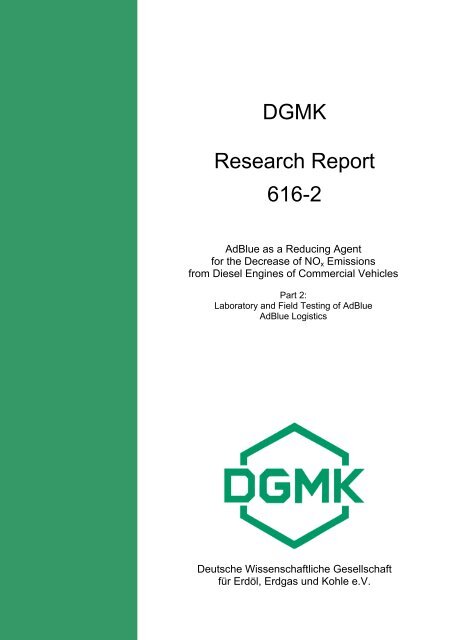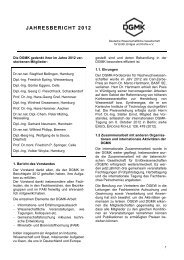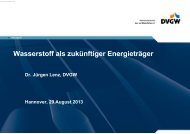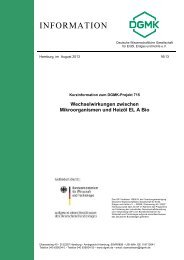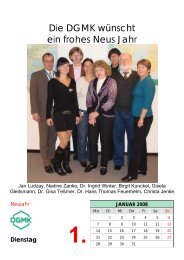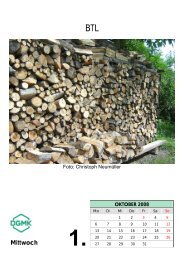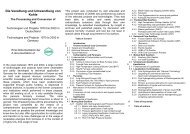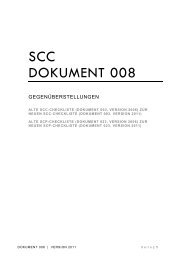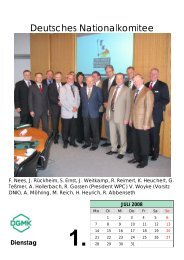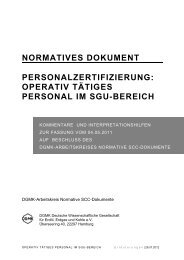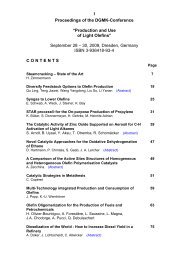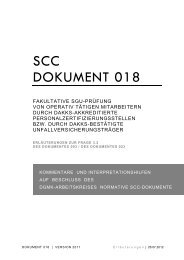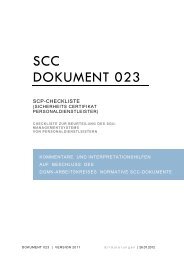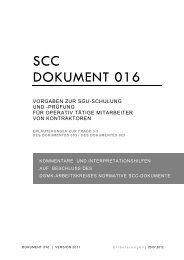Summary - DGMK
Summary - DGMK
Summary - DGMK
You also want an ePaper? Increase the reach of your titles
YUMPU automatically turns print PDFs into web optimized ePapers that Google loves.
<strong>DGMK</strong><br />
Research Report<br />
616-2<br />
AdBlue as a Reducing Agent<br />
for the Decrease of NOx Emissions<br />
from Diesel Engines of Commercial Vehicles<br />
Part 2:<br />
Laboratory and Field Testing of AdBlue<br />
AdBlue Logistics<br />
Deutsche Wissenschaftliche Gesellschaft<br />
für Erdöl, Erdgas und Kohle e.V.
<strong>DGMK</strong> does not accept any liability under any legal aspect for damages alleged to be caused by<br />
reliance on this publication and the findings and conclusions contained therein.<br />
Die <strong>DGMK</strong> und der Bearbeiter haben das Vorhaben mit wissenschaftlicher Genauigkeit und Sorgfalt<br />
durchgeführt. Es wird keine Gewähr für die Anwendbarkeit der in diesem Bericht mitgeteilten<br />
Ergebnisse übernommen.<br />
All rights reserved. No part of this publication may be reproduced, stored in a retrieval system, or<br />
transmitted in any form or by any means, electronic, mechanical, photocopying, recording, or<br />
otherwise, without the prior written permission of <strong>DGMK</strong>.<br />
Alle Rechte, auch die der Übersetzung, des auszugsweisen Nachdrucks, der Herstellung von<br />
Mikrofilmen und der fotomechanischen Wiedergabe,<br />
nur mit ausdrücklicher schriftlicher Genehmigung der <strong>DGMK</strong>.<br />
Manuscript printed.<br />
Als Manuskript gedruckt.<br />
ISSN 0937-9762<br />
ISBN 3-936418-36-5<br />
Price EUR 50,00 Preis<br />
(<strong>DGMK</strong> Members 50 % <strong>DGMK</strong>-Mitglieder)<br />
plus VAT<br />
zzgl. ges. MwSt.<br />
Distribution and sales only by:<br />
Verbreitung und Verkauf nur durch:<br />
Deutsche Wissenschaftliche Gesellschaft<br />
für Erdöl, Erdgas und Kohle e.V.<br />
(German Society for Petroleum and Coal<br />
Science and Technology)<br />
Kapstadtring 2, 22297 Hamburg<br />
Telefon: (040) 63 90 04-31/33/32<br />
Telefax: (040) 63 00 736<br />
Bankverbindung:<br />
Dresdner Bank AG, Hamburg, Konto 9 085 166 00<br />
(BLZ 200 800 00)<br />
Amtsgericht Hamburg 69 VR 6898
German Society for Petroleum and Coal<br />
Science and Technology<br />
<strong>DGMK</strong>-Research Report 616-2<br />
AdBlue as a Reducing Agent for the Decrease of NOx Emissions<br />
from Diesel Engines of Commercial Vehicles<br />
Part 2: Laboratory and Field Test Results of AdBlue<br />
AdBlue Logistics<br />
Abstract:<br />
In order to comply with stringent exhaust gas emission standards issued by the European<br />
Union for 2005 and 2008 for diesel engines of HD (heavy duty) commercial vehicles, the<br />
European automobile industry has chosen the „selective catalytic reduction“ (SCR)<br />
technology. By this method, nitrogen oxide (NOx) emissions can be reduced by 60 % vis-àvis<br />
current standards. In addition they agreed to use „AdBue“, an aqueous solution of urea,<br />
as a reducing agent, which is needed to reduce the oxides of nitrogen into elementary<br />
nitrogen. The first vehicles equipped with this new technology will be launched in January<br />
2005.<br />
This report explains the mechanism of the SCR/urea technique and outlines production as<br />
well as physical, chemical and environmental properties of urea and AdBlue. It summarises<br />
the results of laboratory and field tests, which were run in order to investigate the technical<br />
and logistical requirements of this new technique, and it describes first experiences gained at<br />
public service stations, which have been equipped with an AdBlue filling station. Finally, the<br />
report reflects on what is needed for the build-up of an AdBlue distribution network.<br />
Length of the report: 27 pages, 3 tables, 4 figures, 4 annexes, 13 references<br />
Duration: 2003 – 2004<br />
Author: Dr. Wolf-Peter Trautwein, Hamburg<br />
Project Coordination: Dr. B.-R. Altmann, <strong>DGMK</strong>, Hamburg<br />
<strong>DGMK</strong> Committee: Storage, Transportation and Distribution<br />
<strong>DGMK</strong> Division: Refining and Product Application<br />
Published: Hamburg, February 2005
Projectadvisors: A. Aehle, ELAFLEX Tankstellentechnik GmbH, Hamburg<br />
M. Angelopoulos, ESSO Deutschland GmbH, Hamburg<br />
E. Auer, AMI Agrolinz Melamine International GmbH, A – Linz<br />
Dr. K. E. Austmeyer, HORN GmbH & Co. KG, Flensburg<br />
J.-U. Brandis, UNITI e.V. , Hamburg<br />
J. Ebner, Daimler Chrysler AG, Stuttgart<br />
H. T. Ebner, VDA Verband der Automobilindustrie e.V., Frankfurt<br />
G. Emmerling, MAN Nutzfahrzeuge AG, Nürnberg<br />
M. Frankrone, Yara Industrial GmbH, Oberhausen<br />
A. Graf Bülow, BfT e.V., Bonn<br />
M. Günther, Tankschutz Bott GmbH, Bad Brückenau<br />
L. Hahn, OMV Deutschland GmbH, Landshut<br />
J. Heise, Union Technik GmbH & Co. KG, Duisburg<br />
P. Jagnow, Dresser Europe GmbH, Einbeck<br />
H.-J. Kalisch, ESSO Deutschland GmbH, Hamburg<br />
F.-J. Kersting, Gilbarco GmbH & Co KG, Salzkotten<br />
S. Kunter, FAFNIR GmbH, Hamburg<br />
B. Krause, Umweltbundesamt, Berlin<br />
H. Maahsen, TOKHEIM GmbH, München<br />
M. Øverlie, Yara International ASA, N - Oslo<br />
P. Pröhl, SKW Stickstoffwerke Piesteritz GmbH, Lutherstadt Wittenberg<br />
G. Sasse, Mineralölwirtschaftsverband e.V., Hamburg<br />
M. Schmidt, Shell Global Solutions (Deutschland) GmbH, Hamburg<br />
P. Schnell, Total Deutschland GmbH, Berlin<br />
B. Scholtissek, Deutsche BP AG ARAL Forschung, Bochum<br />
Dr. B. Schulwitz, GMA-Ges. für Mineralöl-Analytik und Qualitätsmanagement mbH + Co.<br />
KG, Hamburg<br />
Dr. J. Seiler, VDA Verband der Automobilindustrie e.V., Frankfurt<br />
T. Spietczack, Shell Deutschland Oil GmbH, Hamburg<br />
Dr. M. Stöckli, Iveco Motorenforschung GmbH, CH – Arbon<br />
P.M.J. Thomassen, Kuwait Petroleum Research & Technology B.V., NL – Hoogvliet<br />
Dr. K. von Kurnatowski, SKW Stickstoffwerke Piesteritz GmbH, Lutherstadt Wittenberg<br />
F. Weidner, BASF AG, Ludwigshafen
Deutsche Wissenschaftliche Gesellschaft<br />
für Erdöl, Erdgas und Kohle e.V.<br />
<strong>DGMK</strong>-Forschungsbericht 616-2<br />
AdBlue als Reduktionsmittel für die Absenkung der NOx-Emissionen<br />
aus Nutzfahrzeugen mit Dieselmotor<br />
Teil 2: AdBlue-Erprobung in Labor- und Feldtesten<br />
AdBlue-Logistik<br />
Kurzfassung:<br />
Um die verschärften Abgasnormen für Dieselmotoren schwerer Nutzfahrzeuge zu erfüllen,<br />
die die Europäische Union für die Jahre 2005 und 2008 (Euro 4 bzw. 5) erlassen hat, hat die<br />
europäische Automobilindustrie sich auf das Verfahren der „selektiven katalytischen<br />
Reduktion“ (SCR-Verfahren) geeinigt. Mit dieser Methode ist es möglich, die Stickoxid-<br />
Emissionen um die erforderlichen 60 % gegenüber den heutigen Standards zu reduzieren.<br />
Außerdem hat sie sich darauf geeinigt, „AdBlue“, eine wässrige Harnstoff-Lösung, als<br />
Reduktionsmittel zu verwenden, das benötigt wird, um die Stickoxide in elementaren<br />
Stickstoff umzusetzen. Die ersten, mit der SCR-Technologie ausgerüsteten Nutzfahrzeuge<br />
werden ab 2005 auf den Markt gebracht.<br />
Dieser Forschungsbericht erläutert die Wirkungsweise der SCR/Harnstoff-Technologie und<br />
beschreibt Produktion sowie physikalische, chemische und ökologische Eigenschaften von<br />
Harnstoff und AdBlue. Er fasst die Ergebnisse von Labor- und Feldtesten zusammen, die<br />
durchgeführt wurden, um die technischen und logistischen Anforderungen der neuen<br />
Technologie zu untersuchen, und schildert erste Erfahrungen, die an öffentlichen Tankstellen<br />
mit einer AdBlue-Zapfanlage gewonnen wurden. Schließlich schildert er, was für den Aufbau<br />
eines europaweiten, flächendeckenden Verteilungsnetzes für AdBlue erforderlich ist.<br />
Berichtsumfang: 27 Seiten, 3 Tabellen, 4. Abbildungen, 4 Anhänge<br />
Laufzeit: 2003 – 2004<br />
Autor: Dr. Wolf-Peter Trautwein, Hamburg<br />
Projektkoordination: Dr. B.-R. Altmann, <strong>DGMK</strong>, Hamburg<br />
<strong>DGMK</strong>-Fachausschuss: Lagerung, Transport und Verteilung<br />
<strong>DGMK</strong>-Fachbereich: Verarbeitung und Anwendung<br />
Veröffentlichung: Hamburg, Februar 2005
Projektbegleitung: A. Aehle, ELAFLEX Tankstellentechnik GmbH, Hamburg<br />
M. Angelopoulos, ESSO Deutschland GmbH, Hamburg<br />
E. Auer, AMI Agrolinz Melamine International GmbH, A – Linz<br />
Dr. K. E. Austmeyer, HORN GmbH & Co. KG, Flensburg<br />
J.-U. Brandis, UNITI e.V. , Hamburg<br />
J. Ebner, Daimler Chrysler AG, Stuttgart<br />
H. T. Ebner, VDA Verband der Automobilindustrie e.V., Frankfurt<br />
G. Emmerling, MAN Nutzfahrzeuge AG, Nürnberg<br />
M. Frankrone, Yara Industrial GmbH, Oberhausen<br />
A. Graf Bülow, BfT e.V., Bonn<br />
M. Günther, Tankschutz Bott GmbH, Bad Brückenau<br />
L. Hahn, OMV Deutschland GmbH, Landshut<br />
J. Heise, Union Technik GmbH & Co. KG, Duisburg<br />
P. Jagnow, Dresser Europe GmbH, Einbeck<br />
H.-J. Kalisch, ESSO Deutschland GmbH, Hamburg<br />
F.-J. Kersting, Gilbarco GmbH & Co KG, Salzkotten<br />
S. Kunter, FAFNIR GmbH, Hamburg<br />
B. Krause, Umweltbundesamt, Berlin<br />
H. Maahsen, TOKHEIM GmbH, München<br />
M. Øverlie, Yara International ASA, N - Oslo<br />
P. Pröhl, SKW Stickstoffwerke Piesteritz GmbH, Lutherstadt Wittenberg<br />
G. Sasse, Mineralölwirtschaftsverband e.V., Hamburg<br />
M. Schmidt, Shell Global Solutions (Deutschland) GmbH, Hamburg<br />
P. Schnell, Total Deutschland GmbH, Berlin<br />
B. Scholtissek, Deutsche BP AG ARAL Forschung, Bochum<br />
Dr. B. Schulwitz, GMA-Ges. für Mineralöl-Analytik und Qualitätsmanagement mbH + Co.<br />
KG, Hamburg<br />
Dr. J. Seiler, VDA Verband der Automobilindustrie e.V., Frankfurt<br />
T. Spietczack, Shell Deutschland Oil GmbH, Hamburg<br />
Dr. M. Stöckli, Iveco Motorenforschung GmbH, CH – Arbon<br />
P.M.J. Thomassen, Kuwait Petroleum Research & Technology B.V., NL – Hoogvliet<br />
Dr. K. von Kurnatowski, SKW Stickstoffwerke Piesteritz GmbH, Lutherstadt Wittenberg<br />
F. Weidner, BASF AG, Ludwigshafen
Table of Contents<br />
<strong>Summary</strong> 1<br />
Zusammenfassung 3<br />
1 Introduction: Reason and Objective 5<br />
1.1 Euro standards for the reduction of exhaust gas emissions 5<br />
1.2 The technology of selective catalytic reduction 6<br />
1.3 Technical and logistic requirements 8<br />
2 Properties of Urea and AdBlue 9<br />
2.1 Urea 9<br />
2.2 AdBlue 9<br />
3 Laboratory and Field Testing of AdBlue 11<br />
3.1 Stability tests 11<br />
3.2 Field tests 12<br />
3.3 Compatibility with other materials 12<br />
3.4 Emulsion test 12<br />
3.5 Result 12<br />
4 Field Tests with SCR Vehicles 13<br />
4.1 Functional tests of DaimlerChrysler 13<br />
4.1.1 Winter tests in Rovaniemi, Finland, early 2003 13<br />
4.1.2 Winter tests in Rovaniemi, Finland, winter of 2003/04 14<br />
4.1.3 Summer tests in Spain in 2004 14<br />
4.1.4 Result 15<br />
4.2 Functional tests by MAN 15<br />
4.2.1 Summer tests in 2003 and 2004 15<br />
4.2.2 Winter tests in 2003/04 15<br />
5 AdBlue Testing at Public Service Stations 17<br />
5.1 OMV service station at Dingolfing, Bavaria 17<br />
5.2 Total service stations at Berlin and Stuttgart 18<br />
6 Logistics 21<br />
7 Conclusions 23<br />
8 References 25<br />
9 Attachments 27
<strong>Summary</strong><br />
The Parliament of the European Union has issued stricter emission standards (Euro<br />
4 and 5) for HD diesel engines for the years 2005 and 2008. Compared to current<br />
limits, an emission reduction of 60 % for nitrogen oxides and of 80 % for particulate<br />
matter will be required.<br />
After testing and comparing various technical options, the European manufacturers of<br />
HD commercial vehicles have agreed on one method for meeting these standards:<br />
the „selective catalytic reduction“ (SCR technology), which, in the presence of a<br />
reducing agent, converts nitrogen oxides into nitrogen and water, which are natural<br />
components of our atmosphere. The European automobile industry has also agreed<br />
on one reducing agent: an aqueous solution of urea, which will be distributed under<br />
the trade name „AdBlue“.<br />
This report describes the mechanism and advantages of the SCR/urea technology.<br />
The main reason for the decision of the manufacturers of HD vehicles was the fact<br />
that this technique, according to current knowledge, appears to be the only method,<br />
which enables the necessary decrease of all exhaust gas emissions to the level of<br />
Euro 5, while maintaining engine optimization with regard to performance and fuel<br />
economy. Furthermore this method can be applied to all types of engines.<br />
In addition this report describes properties and environmental impact of urea as well<br />
as its aqueous solution. According to the European product classification guideline,<br />
AdBlue poses no serious risk to humans, animals or the environment, if properly<br />
handled. Materials used in direct contact with AdBlue must be checked for<br />
compatibility with this product. For production, transportation and storage of AdBlue<br />
very stringent quality requirements have to be observed, in order to avoid impairment<br />
of the efficiency of the SCR catalyst.<br />
Within the scope of this project, a number of pilot and laboratory tests has been<br />
conducted, to investigate storage and thermal stability as well as compatibility of<br />
AdBlue with other materials. Under correct storage conditions, AdBlue is a stable,<br />
easy to handle solution, which does not attack highly alloyed steel, various plastic<br />
materials or seals and which does not form stable emulsions with fuel.<br />
In extended vehicle tests, the European automobile industry has investigated the<br />
suitability of the SCR technology for decreasing NOx emissions and of AdBlue as a<br />
reducing agent. This report describes test results which were achieved under<br />
extreme climatic conditions thus confirming the suitability of the method.<br />
In the course of 2003, the first public service stations have been equipped with<br />
AdBlue filling devices. The experiences, gained since then, have confirmed good<br />
storage stability and easy handling of the product.<br />
The important European manufacturers of commercial vehicles will offer HD trucks<br />
equipped with the SCR/urea technology starting in January 2005. With an AdBlue<br />
tank of 100 l capacity, such vehicles have a travelling range of about 6,000 km. In<br />
Germany, two thirds of the HD trucks are refuelled at private filling stations of the<br />
larger fleet owners, where they could also refuel AdBlue. For an area covering<br />
Europe-wide supply of the other vehicles, it would be sufficient, if the mineral oil trade<br />
would equip a number of their public service stations with AdBlue filling devices along<br />
the main expressways. Starting in 2006, it is planned to also offer lighter trucks and<br />
busses with SCR technique. At that time, private filling stations of larger fleet owners<br />
1
and some public service stations along the main expressways alone may not be<br />
sufficient for an area covering AdBlue supply.<br />
In the meantime AdBlue filling equipment is offered, ranging from smaller mobile<br />
filling systems to fully integrated filling stations with storage tank, heated pipes,<br />
pumps and standardized filling nozzles. The European producers of AdBlue have<br />
entered into contracts with distributors of chemicals to establish a Europe-wide<br />
distribution network for AdBlue.<br />
Thus the area covering supply of HD vehicles with AdBlue should be secured – at<br />
least for the initial phase.<br />
2
Zusammenfassung<br />
Das Parlament der Europäischen Union hat für die Jahre 2005 und 2008 verschärfte<br />
Abgasnormen für Dieselmotoren von schweren Nutzfahrzeugen verabschiedet, die<br />
für die Emission von Stickoxiden eine Reduktion um insgesamt 60 % und die von<br />
Partikeln um 80 % gegenüber den zur Zeit geltenden Grenzwerten verlangen (Euro<br />
4 und Euro 5).<br />
Nach Erprobung und Vergleich verschiedener technischer Möglichkeiten haben sich<br />
die europäischen Hersteller der schweren Nutzfahrzeuge auf ein Verfahren zur<br />
Einhaltung dieser Grenzwerte geeinigt: die „selektive katalytische Reduktion“ (SCR-<br />
Verfahren), bei der die Stickoxide in Gegenwart eines Reduktionsmittels in Stickstoff<br />
und Wasserdampf, also natürliche Bestandteile unserer Atmosphäre, umgesetzt<br />
werden. Die europäische Automobilindustrie hat sich ferner darauf verständigt,<br />
einheitlich eine wässrige Lösung von Harnstoff als Reduktionsmittel einzusetzen, die<br />
unter der Bezeichnung „AdBlue“ vertrieben werden soll.<br />
Im vorliegenden Bericht werden Wirkungsweise und Vorteile der SCR/Harnstoff-<br />
Technologie beschrieben. Maßgeblich für den Beschluss der Nutzfahrzeughersteller<br />
ist die Tatsache, dass diese Technik nach heutiger Kenntnis das einzige Verfahren<br />
darstellt, welches die erforderliche Absenkung aller Abgasemissionen auf das Niveau<br />
von Euro 5 bei gleichzeitiger Optimierung des Motors hinsichtlich Leistungsverhalten<br />
und Kraftstoffverbrauch ermöglicht. Außerdem ist dieses Verfahren bei allen Motoren<br />
anwendbar.<br />
Der Bericht beschreibt außerdem Eigenschaften und Umweltverhalten sowohl des<br />
Harnstoffs als auch seiner wässrigen Lösung. AdBlue ist gemäß den europäischen<br />
Einstufungsrichtlinien bei ordnungsgemäßer Verwendung ungefährlich für Mensch,<br />
Tier und Umwelt. Beim Umgang mit AdBlue sind Werkstoffe mit entsprechender<br />
Chemikalienbeständigkeit zu verwenden. An Produktion, Transport und Lagerung<br />
von AdBlue werden außerdem besonders strenge Qualitätsanforderungen gestellt,<br />
damit der SCR-Katalysator durch das Reduktionsmittel nicht in seiner Wirksamkeit<br />
beeinträchtigt wird.<br />
Im Rahmen dieses Projektes wurden einige Pilot- und Laborteste durchgeführt, mit<br />
denen die Lager- und thermische Stabilität sowie die Verträglichkeit von AdBlue mit<br />
anderen Materialien untersucht wurden. AdBlue ist unter normalen<br />
Lagerungsbedingungen eine stabile Lösung, die sich gut handhaben lässt,<br />
hochlegierte Stähle sowie eine Reihe von Kunststoffen und Dichtungsmaterialien<br />
nicht angreift und mit Kraftstoffen keine stabilen Emulsionen bildet.<br />
Die europäische Automobilindustrie hat in ausgedehnten Fahrzeugtesten die<br />
Eignung der SCR-Technologie zur Herabsetzung der NOx-Emissionen sowie der<br />
AdBlue-Lösung als Reduktionsmittel untersucht. Der Bericht beschreibt die<br />
Testergebnisse, die vor allem unter extremen klimatischen Bedingungen ermittelt<br />
wurden und die Eignung dieses Verfahrens bestätigten.<br />
Im Laufe des Jahres 2003 wurden die ersten öffentlichen Tankstellen mit einer<br />
AdBlue-Zapfanlage ausgerüstet. Die hierbei gemachten Erfahrungen bestätigten die<br />
gute Lagerstabilität und leichte Handhabbarkeit des Produktes.<br />
Mehrere große, europäische Hersteller von Nutzfahrzeugen werden ihre schweren<br />
LKWs ab Januar 2005 in einer SCR-Version anbieten. Mit einem AdBlue-Tank von<br />
100 l Kapazität ausgerüstet, haben solche Fahrzeuge eine Reichweite von rund 6000<br />
km. Zwei Drittel der schweren LKWs in Deutschland werden an betriebseigenen<br />
3
Tankstellen betankt, wo sie dann auch mit AdBlue versorgt werden könnten. Für eine<br />
flächendeckende europaweite Versorgung der übrigen Fahrzeuge würde es<br />
ausreichen, wenn die Mineralölwirtschaft entlang der Hauptverkehrsrouten einige<br />
Tankstellen mit entsprechenden AdBlue-Zapfsäulen ausrüsten würde. Ab 2006<br />
werden auch leichtere LKWs (ab ca. 6 t zGG) und Busse mit SCR-Technik auf den<br />
Markt kommen. Für diese Fahrzeuge reichen dann betriebseigene Tankstellen der<br />
Fuhrparks und wenige öffentliche Tankstellen entlang der Hauptverkehrswege allein<br />
nicht mehr für eine flächendeckende AdBlue-Versorgung aus.<br />
Inzwischen werden AdBlue-Zapfanlagen angeboten, die von einfachen mobilen<br />
Füllsystemen bis zu voll integrierten Tankanlagen mit Lagertank, beheizten<br />
Leitungen, Pumpen und standardisierten Zapfpistolen reichen. Die europäischen<br />
Hersteller von AdBlue haben internationale Kooperationsverträge mit<br />
Vertriebspartnern, die sich auf die Distribution von Chemikalien spezialisiert haben,<br />
abgeschlossen.<br />
Damit sollte zumindest für die Anlaufphase die flächendeckende Versorgung der<br />
schweren Nutzfahrzeuge mit AdBlue europaweit gesichert sein.<br />
4
1 Introduction: Reason and Objective<br />
1.1 Euro standards for the reduction of exhaust gas emissions<br />
<strong>DGMK</strong> Research Report 616 – 1 of September 2003 dealt with the issue: „AdBlue as<br />
a reduction agent for the decrease of nitrogen oxide emissions (NOx) from diesel<br />
engines of commercial vehicles“ [1]. As described there, at the end of 1999, the<br />
parliament of the EU has issued stricter exhaust gas limit values for diesel engines of<br />
heavy duty (HD) commercial vehicles. According to these new standards, NOx<br />
emissions have to be reduced in two steps in 2005 (Euro 4) and 2008 (Euro 5),<br />
respectively, each time by 30 % vis-à-vis the current limits of Euro 3. Significantly<br />
tighter limits apply to the other pollutants, as well: for carbon monoxide (CO),<br />
unburned hydrocarbons (HC) and most importantly for particulate matter (PM) (table<br />
1 and 2).<br />
Pollutant Euro 3 Euro 4 Euro 5<br />
from 2001 from 2005 from 2008<br />
Nitrogen oxides (NOx) 5.0 3.5 2.0<br />
Carbon monoxide (CO) 2.0 1.5 1.5<br />
Unburned hydrocarbons (HC) 0.66 0.46 0.46<br />
Particulate matter (PM) 0.1 0.02 0.02<br />
Tab. 1: Exhaust gas limits of the EU standard 99/96/EG for HD commercial<br />
vehicles (> 3.5 t; > 85 kW) in g/kWh<br />
Percent<br />
100<br />
80<br />
60<br />
40<br />
20<br />
0<br />
Exhaust Gas Limits<br />
NOx PM CO HC<br />
Tab. 2: Exhaust gas limits for HD commercial vehicles in percent vis-à-vis<br />
the current standard (Euro 3)<br />
5<br />
Euro 3<br />
Euro 4<br />
Euro 5
Whereas the limit values of Euro 4 can still be met with various methods, such as<br />
exhaust gas recirculation in combination with a particle filter, the simultaneous<br />
reduction of NOx and particle emissions to the values of Euro 5 poses a technical<br />
problem, which, according to current knowledge, can only be solved with one specific<br />
method described in the following paragraph [3].<br />
1.2 The technology of selective catalytic reduction<br />
After testing and comparing different technical options, the European manufacturers<br />
of HD commercial vehicles have agreed on one method for compliance with stricter<br />
NOx limit values: the “selective catalytic reduction” (SCR method) [4]. Ammonia (NH3)<br />
is used as a reducing agent; however, due to its aggressiveness and toxicity, it is not<br />
applied as such, but in the form of an innocuous substance, which releases NH3 in<br />
the exhaust gas stream, only. The European automobile industry has agreed to use a<br />
32.5 % by weight aqueous solution of urea as a reducing agent, which is distributed<br />
under the trade name “AdBlue”.<br />
When using the SCR technology, the engine can be operated under optimal<br />
conditions, thus minimising fuel consumption and therefore CO2 emissions as well as<br />
the discharge of all pollutants except NOx. After the combustion gases have left the<br />
engine, they first run through a pre-oxidation catalyst where unburned hydrocarbons,<br />
carbon monoxide and particulate matter are oxidised as completely as possible. NO<br />
is oxidized partly to NO2, because the subsequent reduction proceeds fastest at a<br />
mixing ratio of NO:NO2 of 1:1. Then a pump, which is controlled by a monitoring unit,<br />
injects AdBlue from a separate tank into the hot exhaust gas stream, where it<br />
hydrolyses to NH3 and CO2. In the actual selective reduction, NH3 reacts with the<br />
NO/NO2 mixture to form nitrogen and water (steam), which are regular components<br />
of our breathing air. This chemical reaction takes place on a catalytic converter<br />
consisting of transition metal compounds on a ceramic carrier. Small unused<br />
amounts of NH3 can be oxidised in a subsequent oxidation catalyst (figure 1):<br />
6
Chemical reactions:<br />
• Partial oxidation: 2 NO + O2 → 2 NO2<br />
• Urea hydrolysis: (NH2)2CO + H2O → 2 NH3 + CO2<br />
• Selective reduction: NO + NO2 + 2NH3 → 2N2 + 3H2O<br />
Fig. 1: Scheme of a combined deNOx system for exhaust gas treatment on the<br />
basis of the SCR method [4]<br />
The European manufacturers of commercial vehicles have agreed to use SCR/urea<br />
technology, because this method offers a number of advantages, which no other<br />
method known at this time can provide [5]:<br />
• The engine can be operated at optimal conditions, because the nitrogen<br />
oxides formed in the process are converted into elementary and therefore<br />
innocuous nitrogen in a second step behind the engine.<br />
• The optimal engine adjustment results in a better efficiency (about 5 % less<br />
fuel consumption) and therefore in less CO2 emissions.<br />
• The discharge of all pollutants (NOx, PM, CO and CH) is minimised, thereby<br />
complying with the stringent requirements of Euro 4 and 5.<br />
• The SCR/urea technology is applicable to all types of engines and functions<br />
with diesel fuels of varying qualities.<br />
• The SCR method is maintenance-free and designed for the entire lifespan of<br />
the vehicle.<br />
• SCR has no influence on service and oil change intervals of the vehicles.<br />
• In some European countries, SCR equipped vehicles are eligible for certain<br />
financial incentives, such as reduced expressway fees (10 instead of 12<br />
cent/km in Germany, starting in 2005, planned in Switzerland and Austria),<br />
lower taxes or more favourable depreciation rates.<br />
In the medium- and long-term, a technical and economical alternative to the SCR<br />
technology for compliance with the Euro 5 standard is not in sight. This method offers<br />
the most cost-efficient solution with regard to environmental protection and efficiency.<br />
7
1.3 Technical and logistic requirements<br />
After the European car manufacturers had committed themselves to the SCR/urea<br />
technology, they then expected that mineral oil industry and trade will provide the<br />
required AdBlue - possibly in the same way like fuels – through the public service<br />
station net in a Europe-wide and area-covering manner. This expectation resulted in<br />
a number of unresolved issues with regard to technical and logistic requirements:<br />
• Standardisation and quality assurance of AdBlue (from product delivery by the<br />
producer to sale at the dispense pistol)<br />
• Supply and storage of AdBlue at the service station<br />
• Temperature effects (crystallisation, hydrolysis) and storage stability<br />
• Compatibility with other materials (metals, concrete pavement, seals)<br />
• Behaviour in an oil separator<br />
• Interface filling nozzle/filler neck for the AdBlue fuelling<br />
The automobile and mineral oil industry have run various laboratory, service station<br />
and vehicle tests, in order to resolve these questions. The results are described in<br />
this research report 616-2 (chapter 3 to 5). In addition, this report contains some<br />
considerations about the Europe-wide supply of HD commercial vehicles with AdBlue<br />
(chapter 6).<br />
8
2 Properties of Urea and AdBlue<br />
2.1 Urea<br />
In view of the importance of urea for the application of the SCR method, this chapter<br />
summarises the most important properties of this substance and its aqueous solution<br />
(see also <strong>DGMK</strong> Research Report 616-1 and the literature quoted there).<br />
Urea is a colour- and odourless, crystalline substance, which is produced<br />
synthetically in large amounts from ammonia and carbon dioxide. It is used mainly in<br />
agriculture as a fertiliser and feed additive, but also in the plastic, textile,<br />
pharmaceutical and particle board industry. Urea as well as its aqueous solutions<br />
(e. g. AdBlue) are of low acute toxicity and do not act as a skin or eye irritant;<br />
sensitising, carcinogenic or mutagenic effects are unknown. Therefore, urea is not<br />
listed as a dangerous substance according to the Hazardous Substances Ordinance<br />
and does not require any labelling according to the Chemicals Act. Urea poses only a<br />
small risk to surface waters and is easily biodegradable. According to transport<br />
regulations, the aqueous solution of urea is classified as a non-hazardous material<br />
and not subject to the Hazardous Incident Ordinance. Urea is classified by the<br />
Consulting Committee for environmentally relevant, existing substances of the<br />
Society of German Chemists in group III, comprising products which represent a low<br />
endangering potential for the general population and the environment according to<br />
current knowledge [6].<br />
2.2 AdBlue<br />
AdBlue is a 32.5 % by weight solution of technically pure urea in demineralized<br />
water. This concentration was chosen, because at this urea content, the<br />
crystallisation point reaches a minimum of minus 11 °C (eutectic mixing ratio). High<br />
demands are made on the purity of the solution, not only during production, but also<br />
during handling, transportation and storage. AdBlue must be kept free of any metal<br />
ions (e.g. Na, K, Mg, Ca, Al and especially heavy metals), because their salts can<br />
clog the pores of the ceramic carrier material or poison the active centres of the<br />
catalyst thereby rendering it ineffective [7]. AdBlue is not inflammable, but can<br />
release ammonia under heat exposure. According to the European product<br />
classification guideline 67/548/EU, AdBlue poses no serious risk to humans, animals<br />
or the environment [8]. However, it should be stored separately from nitrates and<br />
nitrites.<br />
Urea solution corrodes certain materials, such as copper, zinc and unalloyed steels.<br />
Therefore containers, pipes and pumps must be made of stable materials, such as<br />
highly alloyed austenitic steels, different plastic materials (polyethylene, -propylene, -<br />
isobutylene and -fluoroethylene, Viton etc.) and plastic coated metal containers.<br />
Unalloyed and galvanised steels as well as copper and its alloys are not suited. In<br />
view of the crystallisation of AdBlue, which starts at minus 11 °C, storage tanks, filling<br />
stations and valves must be insulated and heated during the winter, if necessary.<br />
Within Cefic, the European producers of urea have prepared a “quality assurance<br />
guidance document”, which describes recommended practices for handling, transport<br />
and storage of the aqueous urea solution to ensure that the AdBlue quality is<br />
maintained from production to the sale to the end-user. This document is shown in<br />
9
attachment 9.1 of this report, dated 15.07.2004. The newest version can be obtained<br />
from the internet [8].<br />
As the European urea producers guarantee, their production capacities are sufficient<br />
to cover the AdBlue demand in Europe, which, according to the latest forecast of<br />
ACEA, will increase from about 280,000 t in 2006 to almost 4 million t in 2012<br />
(information of ACEA from 2. Nov. 2004).<br />
AdBlue Demand [t/year]<br />
4,500,000<br />
4,000,000<br />
3,500,000<br />
3,000,000<br />
2,500,000<br />
2,000,000<br />
1,500,000<br />
1,000,000<br />
500,000<br />
0<br />
Total AdBlue Demand (EU-25)<br />
Total AdBlue Demand (EU-15)<br />
Total AdBlue Demand (10 new EU states)<br />
2005 2006 2007 2008 2009 2010 2011 2012<br />
Year<br />
Tab. 3: AdBlue demand in the European Union according to an estimate of<br />
ACEA, November 2004<br />
10
3 Laboratory and Field Testing of AdBlue<br />
In 2003, the Research Department of Aral, Bochum, has carried out the following<br />
tests within the scope of <strong>DGMK</strong> Research Project 616:<br />
1. Stability tests<br />
• Storage stability<br />
• Thermal stability<br />
2. Field tests<br />
• Handling: filler nozzle/spills/ drippings/cleaning<br />
• Winter operation (temperatures between –4 and –8 °C)<br />
• Summer operation (temperatures up to 32 °C)<br />
3. Compatibility with other materials<br />
• Concrete<br />
• Metals and plastic material<br />
• Seals<br />
4. Emulsion test<br />
• Separation of fuel/AdBlue mixtures<br />
These tests have shown the following results:<br />
3.1 Stability tests<br />
AdBlue was stored at room temperature; after half a year, the solution showed no<br />
significant changes of the quality characteristics defined by DIN V 70 070. At the end<br />
of the test, all specified values were within the limits of the DIN standard.<br />
In storage stability tests at higher temperatures, slightly different results were<br />
achieved: At a storage temperature of 50 °C, only very small amounts of ammonia<br />
were developed; after about 100 hours at 70 °C, the NH3 concentration of the AdBlue<br />
solution increased beyond the limit value of 0.2 % by weight as specified by the DIN<br />
standard, and it reached a value of 1.4 % by weight NH3 after 350 hours (attachment<br />
9.2). Based on these tests of Aral, AdBlue is relatively stable at storage temperatures<br />
of up to 50 °C; at higher temperatures, however, an increasing hydrolysis of urea<br />
takes place.<br />
11
3.2 Field tests<br />
For these tests, Aral installed an ‘intermediate bulk container’ (IBC), which was filled<br />
with AdBlue. Handling of the urea solution turned out to be without any problems.<br />
Stains of smaller drops, which resulted from filling AdBlue with a filler nozzle, could<br />
be removed easily. Lasting stains developed only, if these drops were not removed<br />
from the concrete floor (B35) within a few days.<br />
Summer operations at temperatures of up to 30 °C confirmed the lab tests about the<br />
thermal stability of AdBlue. Apart from very minor smells, no significant changes or<br />
nuisance factors could be attributed to AdBlue (the odour threshold value of NH3 is<br />
between 10 and 20 ppm [9].<br />
Winter operations could not be run, since ambient temperatures did not fall below –8<br />
°C and therefore did not reach the crystallisation point of AdBlue of –11 °C. No<br />
problems were observed at a temperature of –8 °C, which prevailed for a few days,.<br />
3.3 Compatibility with other materials<br />
B 35 concrete cubes and plates were exposed to AdBlue and water for six weeks.<br />
Subsequently, the solutions were analysed for their calcium content. It was<br />
demonstrated that AdBlue does not extract more Ca than water from the concrete,<br />
which is used as a pavement at service stations.<br />
Tests about the compatibility of AdBlue with various metals and plastic materials<br />
confirm the data as shown in DIN V 70 070. Polysulfide was investigated as an<br />
example for seals, and it was found to be stable.<br />
3.4 Emulsion test<br />
Mixtures of AdBlue and diesel fuel were investigated according to an Aral in-house<br />
test method, in order to check, if AdBlue forms stable emulsions with petrol or diesel<br />
fuel, which could impair the function of the oil separator of a service station. For this<br />
purpose, an AdBlue/diesel fuel mixture was stirred in a Turax for 30 seconds at<br />
11,000 rpm. The emulsion formed in the Turax was then centrifuged for 5 minutes at<br />
1,600 rpm. Thereafter, the emulsion had completely separated into an aqueous and<br />
a hydrocarbon layer. According to Aral’s experiences, these test results show, there<br />
are no problems to be expected with emulsion formation in an oil separator.<br />
3.5 Result<br />
The results of the above mentioned pilot and lab tests of the Aral Research<br />
Department can be summarized as follows: AdBlue is a stable solution, even under<br />
extended time periods, if stored properly. It can be handled without difficulties, does<br />
not attack concrete, highly alloyed steels, plastic materials and seals, and it does not<br />
form stable emulsions with fuel oils.<br />
12
4 Field Tests with SCR Vehicles<br />
4.1 Functional tests of DaimlerChrysler<br />
Already prior the decision for the SCR method, DaimlerChrysler had tested ten<br />
Mercedes-Benz commercial vehicles over a distance totalling 3.2 million kilometres<br />
[10]. The specific purpose of this report is to describe more recent field tests, which<br />
were mainly carried out to test the suitability of the method under extreme climatic<br />
conditions.<br />
4.1.1 Winter tests in Rovaniemi, Finland, early 2003<br />
The results of the first winter tests with regard to the vehicles can be summarised as<br />
follows:<br />
• The components have proven their suitability for winter conditions.<br />
• The heating of the AdBlue system with cooling water was successful.<br />
• The total system of the vehicles needs further optimisation; especially the<br />
heating system under extreme conditions requires improvement.<br />
• For the assessment of the total system, additional investigations in a cooling<br />
cell and further tests are planned.<br />
The results of these winter tests with regard to the AdBlue filling stations yielded the<br />
following:<br />
• In the cooling cell, vehicles could be refuelled at temperatures down to –20 °C<br />
without any problems.<br />
• During subsequent field tests in Finland, the content of the tank was heated to<br />
more than 10 °C. Nevertheless, filling nozzle and pump occasionally failed.<br />
• The outdoor version of the AdBlue filling station worked satisfactorily at<br />
temperatures to –20 °C. At temperatures between –30 and –34 °C, pipes and<br />
pumps froze up, resulting in a rupture of an impeller gear tooth. The filling<br />
station worked satisfactorily again, after exchange of the impeller gear and<br />
raising the temperature over 24 °C by intensified heating.<br />
13
4.1.2 Winter tests in Rovaniemi, Finland, winter of 2003/04<br />
After initial tests of four vehicles and two filling stations, the vehicles were parked<br />
from Dec. 15, 2003 to Jan. 22, 2004. Four freezing cycles with complete freezing and<br />
thawing were carried out during this time. No problems were experienced during the<br />
subsequent start and operation, but the heating by cooling water required about two<br />
hours to thaw the content of a large, completely frozen AdBlue tank. However, by<br />
appropriate design of the heating pipes, it was possible, to pump AdBlue out of the<br />
tank already after a heating period of about 15 minutes. Since it takes two to three<br />
days, until an AdBlue tank is completely frozen – even at very low temperatures –<br />
these heating times should not pose any problem in practise, because commercial<br />
vehicles are usually operated without any breaks, and therefore, the tank filling is<br />
kept at sufficiently high temperatures by the heated cooling water of the engine.<br />
Successful driving tests with twelve Euro 4 vehicles at temperatures down to –20 °C<br />
were carried out from Jan. 23 to Feb. 16, 2004.<br />
Heated mobile filling stations of Bott (1000 l IBC) and Ucon (1000 l container) were<br />
used for refuelling. The Elaflex filling nozzle was equipped with a magnetic lock; its<br />
final cut-off system needs further improvement (too much dripping).<br />
4.1.3 Summer tests in Spain in 2004<br />
Fifteen Euro 4 trucks (Actros, Axor and Atego as well as two city buses, one Unimog<br />
and one Econic) were tested in Granada from July 5 to August 2, 2004 at ambient<br />
temperatures between +30 °C and +40 °C. The test vehicles covered a distance of<br />
almost 100,000 km.<br />
No functional failures and no breakdown of the exhaust gas after-treatment occurred.<br />
Again, filling stations of Bott and Ucon with filling nozzles of Elaflex were used.<br />
AdBlue had been produced by Yara.<br />
A total of 1,400 l AdBlue were consumed during these tests. The heavier vehicles<br />
consumed between 1.4 and 2.0 l/100 km, the smaller ones 0.8 to 1.4 l/100 km; this<br />
corresponds to 4 – 5 % of diesel consumption.<br />
The investigation was focussed on the following crucial points:<br />
• Function of the dosage unit: The control of the dosage unit worked<br />
satisfactorily. There were no leaks. Smaller leaks at other locations could be<br />
eliminated.<br />
• Testing of the AdBlue tank unit on board the vehicles under extreme heat and<br />
road conditions: The vehicles were equipped with aluminium tanks (AlMg3<br />
alloy); their capacity ranged from 25 to 110 l. There were no malfunctions of<br />
the tank unit, even when the tanks on the vehicle were exposed to direct sun<br />
light, thus reaching temperatures of 40 to 50 °C. There were no leaks at the<br />
tanks and no nuisances by odours during the venting of tanks.<br />
14
• Measurements at the SCR unit at high ambient temperatures: The unit<br />
functioned troublefree. All temperatures measured were at target value.<br />
Neither the catalytic converter nor the adjacent components reached<br />
inadmissible temperatures.<br />
• Testing the refuelling process: The refuelling unit had a pump delivery rate of<br />
30 l/min. After optimisation of the filling nozzle by Elaflex, the cut-off system of<br />
the pump worked correctly, when the tank was full. However, the discharge of<br />
remaining amounts of liquid after cut-off were too high despite the magnetic<br />
cut-off. There were no nuisance factors caused by odours during the refuelling<br />
process.<br />
4.1.4 Result<br />
In summary, it can be stated that the SCR technology is a reliable method for the<br />
reduction of NOx emissions; it functions satisfactorily – even under the extreme<br />
conditions of a winter in Finland or a summer in southern Spain.<br />
4.2 Functional tests by MAN<br />
MAN conducted the following vehicle tests with AdBlue:<br />
4.2.1 Summer tests in 2003 and 2004<br />
A truck equipped with SCR technology was driven through Spain for three weeks<br />
during the summer of 2003. A plastic tank filled with AdBlue was installed on the<br />
vehicle. Refuelling did not pose any problems despite high temperatures. There were<br />
no noticeable odours. The test was repeated in southern Spain, starting July 7, 2004.<br />
Again there were no technical problems or any nuisance factors by odour.<br />
4.2.2 Winter tests in 2003/04<br />
An SCR vehicle was driven through Sweden for three weeks during the winter of<br />
2003/04. It was refuelled at a container service station without any problems – even<br />
at temperatures of –32 °C. The heating of the AdBlue tank by the cooling water of the<br />
engine was sufficient to keep the AdBlue solution liquid, also at ambient<br />
temperatures below –30 °C.<br />
Remark: MAN has decided to comply with the requirements of Euro 4 by measures<br />
alternative to the SCR technology. For this purpose MAN uses a further developed<br />
system of cooled exhaust gas recirculation in combination with a particle filter in the<br />
muffler made of high alloyed steel.<br />
15
5 AdBlue Testing at Public Service Stations<br />
The first three public service stations were equipped with an AdBlue filling station in<br />
Germany during the year 2003:<br />
• OMV service station in Dingolfing, Bavaria. Opening March 3, 2003<br />
• Total service station in Berlin. Opening Oct.10, 2003<br />
• Total service station in Stuttgart. Opening on Nov. 19, 2003<br />
In 2004, OMV, Austria, opened the first Austrian service station with AdBlue at the<br />
Inn autobahn in Vomp, Tyrol. In the meantime, OMV has opened further public<br />
service stations at an autobahn: Schnelldorf in Germany and Prostejov in the Czech<br />
Republic. Additionally, OMV has announced plans to equip 67 service stations with<br />
AdBlue filling units throughout Europe by the end of 2007. The company also plans<br />
to offer AdBlue in 10 litre cans at 81 autobahn service stations in ten countries,<br />
starting in January 2005.<br />
The following is a summary of the experiences and test results gained while handling<br />
AdBlue.<br />
5.1 OMV service station at Dingolfing, Bavaria<br />
In early 2003, OMV, Vienna, had agreed to equip the service station in Dingolfing,<br />
Bavaria, with an AdBlue filling unit for a field test within the scope of the <strong>DGMK</strong><br />
Research Project 616-2. On March 3, 2003, the AdBlue test station of Bott was<br />
commissioned, which had already been used during the field tests of DaimlerChrysler<br />
in Finland (chapter 4.1). The AdBlue unit consists of an above ground IBC plastic<br />
container, which was filled with 1000 l AdBlue produced by AMI Agrolinz Melamine<br />
GmbH, and a filling unit with a filling nozzle made by Elaflex. In total, eleven trucks<br />
were refuelled until Oct. 7, 2003. On Feb. 16, 2004, the IBC was replaced by another<br />
one filled with fresh AdBlue.<br />
Figure 2: OMV Service Station in Dingolfing<br />
17
For quality control of the AdBlue solution, samples were taken as required: directly at<br />
the producer and with the filling nozzle from the IBC of the service station at<br />
Dingolfing. The results of these samples show that even after one year of storage, all<br />
analytical characteristics of the AdBlue solution remained essentially unchanged and<br />
within the limits of the DIN standard (attachment 9.3).<br />
These trials demonstrated the suitability of the Bott refuelling unit and the stability of<br />
the AdBlue solution. No smell of ammonia was observed, but some minor deposits of<br />
crystals showed up at locations, where water could evaporate from the solution, such<br />
as the filling nozzle and the filler neck.<br />
5.2 Total service stations at Berlin and Stuttgart<br />
Total opened the first fully integrated AdBlue filling system at a service station in<br />
Berlin in October 2003, and one month later another one in Stuttgart (figure 3 and 4).<br />
Construction work was done by Union Technik. AdBlue is stored in coated under<br />
ground tanks. Pipes leading to the dispensing unit are heated. The integrated filling<br />
system was developed by Dresser-Wayne. According to the results of the monthly<br />
investigations of the filling units by Dresser and Union Technik, both units are<br />
working satisfactorily.<br />
.<br />
Figure 3: Service Station TOTAL, Berlin Alt-Mahlsdorf<br />
18
Figure 4: Service Station TOTAL, Stuttgart Ulmenstraße<br />
SKW Piesteritz provided the AdBlue solution and took monthly AdBlue samples from<br />
both tanks for analysis (attachment 9.4). As the results show, all analytical<br />
characteristics remained practically constant and within the limits of the DIN V 70 070<br />
standard. There was no hydrolytic degradation; the content of heavy metals was<br />
below detection limit. This demonstrates that AdBlue is stable for more than one<br />
year, if stored appropriately.<br />
19
6 Logistics<br />
Some of the truck manufacturers will start to launch the SCR/urea technology for<br />
their HD diesel vehicles at the beginning of 2005. For a successful market<br />
introduction, the automobile industry expects the mineral oil business to provide the<br />
required AdBlue in sufficient amounts and of adequate quality – eventually in an area<br />
covering Europe-wide manner. They expect a stepwise introduction: first mainly at<br />
privately owned filling stations of larger fleets, later at filling stations along<br />
expressways in Europe, and finally through the existing network of public filling<br />
stations for truck fuelling. The set-up of such an infrastructure, especially in its last<br />
phase, would require considerable investments by the mineral oil business for<br />
installation of additional dedicated tanks, pipes, pumps and filling units at the service<br />
stations. Therefore, this chapter describes a few considerations on what is needed to<br />
supply AdBlue for HD commercial vehicles throughout Europe.<br />
Here are some facts about the situation in Germany: In 2003, diesel fuel consumption<br />
amounted to 27.9 million t, 25.1 million t of that in road traffic. About 70 % of the total<br />
diesel fuel (corresponding to 20 million t) is consumed by commercial vehicles. There<br />
are 3.6 million commercial vehicles in Germany (10 % thereof have a load capacity of<br />
over 6 t). Approximately two thirds of the operators of these cars refuel at 3,500<br />
privately owned service stations. About 20 % of the commercial vehicles are refuelled<br />
at truck stops and only 10 % at public service stations [11].<br />
The normal HD commercial vehicle has a diesel fuel tank size of 1,000 l and an<br />
average fuel consumption of 34 l/100 km. It can cover a distance of almost 3,000 km,<br />
corresponding to a trip from Copenhagen to Palermo or from Paris to Moscow. The<br />
AdBlue consumption amounts to ca. 5 % of the diesel fuel consumption. With an<br />
AdBlue tank of 100 l capacity, this vehicle could travel the route Copenhagen –<br />
Palermo both ways, without the need to refuel AdBlue. Even at smaller tank<br />
capacities, the routes of trucks are planned such that refuelling outside the own<br />
refuelling station is unnecessary.<br />
In addition, DaimlerChrysler have announced that they will equip their long-distance<br />
trucks with extra large AdBlue tanks with a capacity of 145 l for the interim period, in<br />
which AdBlue is not offered everywhere; this would allow a travel distance of almost<br />
10,000 km [12].<br />
These considerations show that about two thirds of all HD trucks in Germany can<br />
cover their AdBlue demand at their private service stations – even for trips across<br />
Europe, provided the fleet owner has made the necessary investments for AdBlue<br />
fuelling.<br />
For this purpose, a number of companies (such as Bott and Ucon) are offering<br />
AdBlue dispensing equipment comprising:<br />
• Containers with pump systems, heating and filling nozzles and<br />
• Filling units with heating, flow meters and accounting systems..<br />
This equipment was used successfully in the field tests of the car manufacturers<br />
(chapter 4).<br />
21
The remaining third of commercial vehicles, which refuelles at truck stops and public<br />
service stations, will also require AdBlue at these locations. However, since these<br />
vehicles have the same driving range as the other ones, their AdBlue supply should<br />
be sufficiently guaranteed by service stations along the main expressways. This puts<br />
the request of the automobile industry into perspective for an AdBlue supply at<br />
practically all public service stations in the third and last phase. The mineral oil<br />
business could considerably reduce the investment cost by focussing on the service<br />
stations along the main traffic routes.<br />
In June 2004, four important European urea producers (AMI, BASF, SKW Piesteritz<br />
and Yara Intern.), five manufacturers of commercial vehicles (DAF, DaimlerChrysler,<br />
Iveco, Renault and Volvo) and three mineral oil companies (CEPSA, OMV and Total)<br />
have committed themselves in a joint press release to the concept of the SCR/urea<br />
technology. According to their statement it ideally combines economic and ecological<br />
advantages [13].<br />
AdBlue producers (AMI, BASF, SKW Piesteritz and Yara) have announced cooperations<br />
with distributor companies (OMV, Penta Chemicals and ERC Techology,<br />
Kruse Chemie and Brenntag AG) for the set-up of a German or European AdBlue<br />
infrastructure, which could guarantee the supply of the private as well as public<br />
service stations. The following supply alternatives are offered:<br />
• in a 10 litre can, especially as a reserve tank or emergency supply,<br />
• in a 1000 litre IBC, which can be equipped with pump, heating, filling nozzle or<br />
complete dispensing unit as well as flow meter and accounting system and<br />
• in bulk by tank car for filling 1,000 to 30,000 litre tanks, which can be equipped<br />
with heating, insulation, liquid level indicator, complete encasement, filling<br />
nozzle or complete dispensing unit, flow meter and accounting system.<br />
The AdBlue demand of HD diesel vehicles can thus be guaranteed in an area<br />
covering Europe-wide manner by the privately owned service stations of the fleet<br />
operators and the service stations at truck stops and main expressways. There is no<br />
need for equipping those service stations, which are not frequented by trucks with<br />
SCR systems, with AdBlue filling units.<br />
22
7 Conclusions<br />
The stricter exhaust gas regulatios of the EU, Euro 4 and 5, apply to new types of HD<br />
commercial vehicles in 2005 and 2008, respectively, and they become effective for all<br />
newly commissioned vehicles one year later. The technology of selective catalytic<br />
reduction has proven to be a reliable and safe method for meeting these rigid<br />
regulations in a number of field tests, not only in stationary, but also mobile<br />
applications – even under extreme climatic conditions.<br />
Starting in 2005, the car manufacturers will offer their customers HD trucks equipped<br />
with this technique. The European urea producers will provide the AdBlue needed for<br />
the SCR method in sufficient amounts and of required quality, and they have<br />
announced co-operations with distributor partners for the set-up of an AdBlue<br />
distribution network.<br />
Two thirds of all HD trucks in Germany will cover their AdBlue demand at the service<br />
stations of their truck depots, provided the fleet owners have made the necessary<br />
investments for AdBlue tanking. The other vehicles can be supplied at truck stops<br />
and public service stations.<br />
In the meantime, some mineral oil companies have started to equip their first service<br />
stations with AdBlue filling systems. Others plan to offer AdBlue in 10 litre cans at<br />
their stations. Due to the relatively small AdBlue consumption of less than 2 l/100 km,<br />
vehicles equipped with an AdBlue tank of 100 l capacity can criss-cross Europe<br />
without the need to refuel the reducing agent. Therefore the AdBlue distribution<br />
network does not need to be too tight.<br />
In view of these facts, the stepwise expansion of the SCR technology should be on<br />
the right target in the very near future.<br />
23
8 References<br />
[1] <strong>DGMK</strong> Research Report 6161-1: AdBlue as a reducing agent for the decrease<br />
of NOx emissions from diesel engines of commercial vehicles, Hamburg,<br />
September 2003<br />
[2] Directive 1999/96/EU of the European Parliament and the Council of 13<br />
December 1999 on the approximation of the laws of the Member States<br />
relating to measures to be taken against the emission of gaseous and<br />
particulate pollutants from compression ignition engines for use in vehicles,<br />
and the emission of gaseous pollutants from positive ignition engines fuelled<br />
with natural gas or liquefied petroleum gas for use in vehicles and amending<br />
Council Directive 88/77/EEC<br />
[3] Selective Catalytic Reduction (Final Report), ACEA, Brussels, 23.06.2003<br />
[4] Scheme of a combined system for exhaust gas treatment on the basis of the<br />
SCR method, information by Shell Global Solutions GmbH, 2003<br />
[5] ACEA Statement on the Adoption of SCR Technology to Reduce Emissions<br />
Levels of Heavy Duty Vehicles, ACEA, Brussels, 05.07.2003<br />
[6] BUA Stoffbericht No. 76, October 1991, Gesellschaft Deutscher Chemiker,<br />
Verlag Chemie, Weinheim<br />
[7] DIN V 70070:2003, Deutsches Institut für Normung e.V., Berlin, published by<br />
Beuth Verlag, Berlin<br />
[8] CEFIC: Automotive Grade Urea – Quality Assurance Guidance Document,<br />
European Chemical Industry Council, Brussels, 15.07.2004. Newest version<br />
under http://www.petrochemistry.net/Product & sector groups/ Automotive<br />
grade urea<br />
[9] Threshold limit value list ammonia, supplement of 1986 and W. S. Ferguson et<br />
al, J. occup. Med. 19, 319 (1977)<br />
[10] VDI nachrichten of 06.09.2002<br />
[11] A. Münch, Brennstoffspiegel, Oct. 2004, S.34<br />
[12] Press release of DaimlerChrysler of 21.6.2004, Wörth<br />
[13] Joint press information about AdBlue: manufacturers of urea and commercial<br />
vehicles and of the mineral oil industry under http.//www.BASF.de<br />
25
9 Attachments<br />
9.1 CEFIC: Automotive Grade Urea – Quality Assurance Guidance Document:<br />
http://www.petrochemistry.net/Product & Sector Groups/Automotive Grade<br />
Urea<br />
9.2 Thermal stability of AdBlue at 70 °C – investigations by Aral Research<br />
Department<br />
9.3 AdBlue analytical results and diagram of storage stability of AdBlue at the<br />
OMV service station at Dingolfing, Bavaria, investigations by AMI Agrolinz<br />
Melamine International GmbH<br />
9.4 AdBlue analytical test results of the Total service stations at Berlin and<br />
Stuttgart, investigations by SKW Stickstoffwerke Piesteritz GmbH<br />
27


